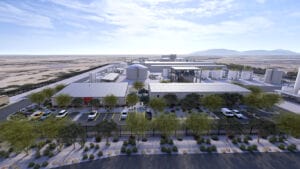Arizona has a serious doctor shortage. The state is a “Designated Health Professional Shortage Area” and according to the latest numbers from the Health Resources & Services Administration, the department that makes these designations, slightly less than half of Arizona’s primary care health professional needs are met.
Video by Jesse A. Millard
Since only 49 percent of the state’s needs are met, Arizona residents, particularly those in the rural parts of the state, are subject to long wait times for regular checkups because of the doctor shortage.
Arizona needs to add 520 physicians in order to lose its “shortage” designation. These doctors won’t appear out of thin air, but Arizona does have a great pool to reel new doctors from — its growing medical schools.
Midwestern University’s Arizona campus in Glendale sees an estimated 40 percent of its graduates residing and practicing in Arizona, says Dr. Kathleen H. Goeppinger, president and CEO of Midwestern University.
The University of Arizona College of Medicine in Phoenix offers a pipeline to local communities. The efforts include Saturday Scrubs and Summer Scrubs, where those interested in the medical field are welcomed into simulation labs to watch students care for mannequins — or faux patients. The hope is the program will spark the interest in those considering a career in the medical field.
And Mayo Clinic welcomed its first class of about 50 students to the Valley this year, making Arizona the third state to receive a Mayo Medical school, behind Minnesota and Florida.
The Mayo Clinic School of Medicine has created a curriculum that is designed to not only teach students how to do certain medical procedures, but also teach them the ins and outs of the healthcare delivery system.
“We want to prepare physicians to meet the needs and challenges of the healthcare system,” says Michele Halyard, MD, dean of the Mayo Clinic School of Medicine’s Arizona campus. “We are hoping that many of the students will wind up staying in Arizona for their residency and ultimately becoming a physician within the Arizona community.”
Class act
In late September, several medical groups in the state formed an alliance that will work to increase the number of doctors and healthcare professionals in Arizona and ease the doctor shortage.
Maricopa Integrated Health System, Creighton University School of Medicine, Dignity Health’s St. Joseph’s Hospital and Medical Center and District Medical Group will work together as the Creighton University Arizona Health Education Alliance to expand Arizona’s offerings of healthcare education programs.
“With this alliance, we have the opportunity to continue to strengthen Arizona’s reputation as the home of some of the best medicine in the nation,” says Patty White, president and CEO of St. Joseph’s. “The affiliation will enable us to increase the numbers of doctors and other healthcare professionals who will want to make Arizona their home.”
Arizona is also on the cutting edge of medical education, training and creating doctors who will be prepared to deliver care in a modern healthcare setting.
This is being done through various medical simulation centers in the state. Simulation is still fairly new in medical training and preparation. However, many medical schools across Arizona are adopting this new practice in hopes of producing better trained physicians.
Simulation centers vary from facility to facility, but they typically involve mannequins that enable students, practitioners and residents to learn how to deal with many different aspects of medical care and treatment.
Innovation abounds
The Banner Simulation Medical Center’s 55,000-square-foot simulation center is one of the largest simulation centers in Arizona, where trainees can fully experience a hospital-like atmosphere.
The center is nestled in a decommissioned, hospital where students can immerse themselves in simulations at an intensive care unit, surgery center, operating rooms and training labs. Students learn how to take blood samples, utilize proper sanitary measures and more, says Karen Josey, senior director of simulation at Banner Health.
“Simulation is all about patient safety,” Josey says. “Simulation goes from simple training such as putting in an IV, to the more complex tasks and scenarios, such as a chest tube insertion.”
The center also offers a day in the life of a nurse, where students are assigned a number of patients that they must watch, prioritize and care for throughout the day. This is followed by hours of debriefing on what needs to be improved and what was done correctly.
The University of Arizona currently has two simulation labs. One located in Tucson — which will open in May of 2018 — and one in Phoenix.
The Phoenix simulation center consists of three wings, 14 hospital rooms, two surgical stations, nine debriefing rooms, six onsite training rooms, three scrub sinks, ultrasound machines, 3-D models of the brain and eyes and a virtual reality simulation.
All of this is in hopes of accomplishing the UA’s “mission of providing the best training to students, residents and fellows, but it also helps recruit and expand our pipeline of students who might consider entering careers in medical fields,” says Guy Reed, dean of the University of Arizona College of Medicine – Phoenix.
Midwestern University is also home to a simulation lab. Its lab is made up of 19 exam rooms and extends to seven veterinary-based exam rooms. Also, there’s an ICU, emergency/trauma room, a pediatric floor, maternal fetal simulator, operating rooms and more.
Arizona is filled with simulation labs, including two more with Mayo Clinic. Mayo’s facility contains about six fully equipped exam rooms that are identical to those in the Mayo Clinic Cancer Center, and another simulation center within its hospital.
Real-world readiness
Students begin their simulation journey with Mayo at the simulation center at its school. This is where the student will learn proper interview techniques and physical diagnosis with people acting out the symptoms based on scripts.
From here, the students are transferred to the simulation center in the hospital to learn more complex techniques.
“The science of medicine is changing at an amazing rate and so, because of that, the education has to evolve as well,” says Halyard.
Each and every simulation lab has the same goal in mind: to provide better, more experienced physicians for the patients of Arizona.
Simulation labs are in pursuit of bridging the gap between physicians and patients in Arizona.
These simulation centers help prepare physicians for real-life circumstances and are giving them the confidence to make their mistakes in a controlled environment, so that they may be more adequate once they enter the healthcare industry.
“I like to say that we want to prepare physicians who not only heal patients, but who can heal the healthcare system as well,” Halyard says.




